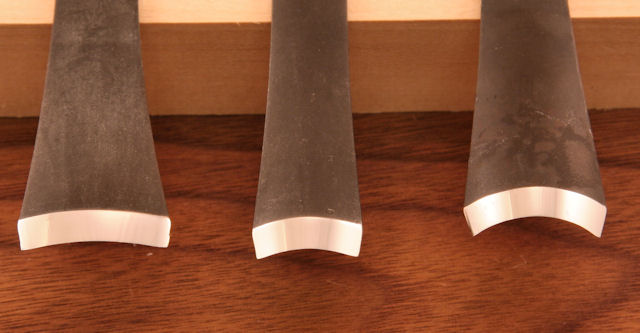Personally I don't buy that one. I think he has been shown that trick by someone and not really understood what it is for.
To create a tiny secondary micro bevel you must remove metal. I don't believe that the top of a landrover window is going to remove metal, it is far harder than the steel and extremely smooth, I just did it on a freshly honed edge and looked under the microscope and saw no effect (maybe VW windows are not as abrasive as landrover) I would be very happy to be proved wrong on that one if anyone can show me any evidence, photos or personal experience that shows that toughened glass can remove metal.
Now one of the most common ways of a knife becoming "blunt" particularly fine edges like kitchen knives and Moras with their secondaries removed is what is called edge roll. What happens is if you visualise the edge of a piece of paper pulled tight then push on the edge, it will buckle one way or the other. That is what happens to the fine edge of the knife, it is not "blunt" and if you can push the edge back into line then it will cut well again. Enter the sharpening steel, or landrover window. To use a steel or window on a freshly honed knife seems pointless to me, to use one on a fine edged knife that has done some work and become edge rolled is an excellent idea and save wasting steel.
Now if Ray was wanting to use a knife with a secondary bevel why spend all that time polishing the primary, it plays no part in cutting if you are working with a secondary.
Incidentally chefs use 2 different kinds of steels, most are nonabrasive and simply for realigning the edge, some are abrasive and designed to remove a small amount of metal.
I think he knows what it's for and he doesn't mention a micro secondary bevel, he explains that it is to give the very edge 'bite'. This is necessary because he has just stropped the edge vigorously for 'strength', he says, which is given by a slight convexing of the very edge. He also mentions that stropping isn't necessary to make the blade sharper, just that it gives strength. The passses on the window edge (which are far from ultra smooth from what I've seen, you only need to compare it visually to the polished glass surface on the side to see this, but it's possible they vary) give back the 'bite' that is lost to stropping.
I don't agree that, even with a slightly less than micro secondary edge, a polished main bevel doesn't have any effect on cutting. It may not affect the very edge, but it does affect cutting efficiency. Also, despite the fact that it doesn't directly affect the very edge, the process by which his knife in the video became smooth in the first place (6000 grit waterstone in this case) is precisely what made it possible for the stropping to have had any effect at all.
The point is, it is not a secondary bevel, it's a micro convexing of the edge (the stropping that is, not the car window).
This at least is the theory of what he is doing. To prove it actually works I think it's necessary to use his knife after he's sharpened it, because it seems to work for him and it's inevitable that when the process is attempted by other people that the result is not exactly the same.
I think it's also useful to remember that RM has money, so when he wants to know something he doesn't just have to ask a mate, it seems to me he asks a scientist more often than not, or at least the current leader of a certain field. I think it unlikely he'd do something such as this without finding out why first.
HTH

